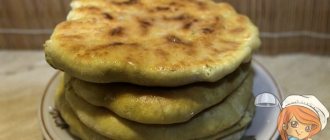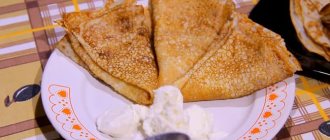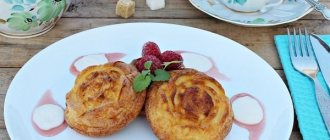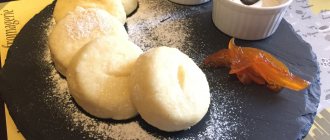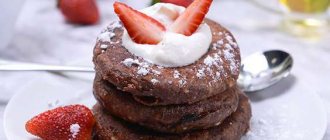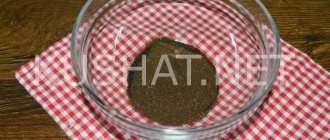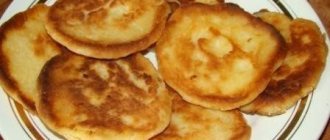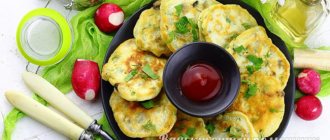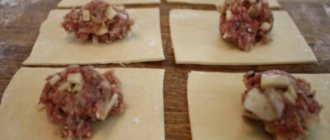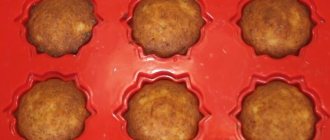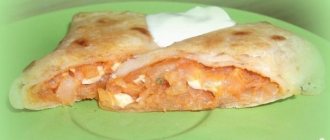Lush cheesecakes on kefir with cottage cheese
Two types of cottage cheese give the dough the necessary fluffiness, the taste of the dish is the best, and the flour is not felt at all.
Ingredients:
- 250 g of 5% store-bought cottage cheese;
- 250 g of homemade fat cottage cheese;
- 250 ml kefir;
- 160-170 g wheat flour;
- 2 eggs of the “Select” category;
- 50 g fine sugar;
- a pinch of fine salt.
Time spent: 25 minutes.
Quantity: 245 kcal.
Step-by-step cooking method:
- Grind homemade and store-bought cottage cheese through a fine sieve.
- Be sure to sift the wheat flour.
- Combine flour with cottage cheese, add fine sugar, eggs, and a pinch of salt.
- Grind the dough until smooth.
- Sprinkle the work surface with flour and form round cheesecakes on it.
- Heat the frying pan, pour in refined oil and fry the cheese balls on each side. 4 minutes is enough.
- Place the cheesecakes on a plate and sprinkle with fine powdered sugar. Serve sour cream separately.
Note: if you take only homemade cottage cheese, the products will fall apart, and if you only use a store-bought product, you will have to add more flour to the dough, and these are no longer cheesecakes.
Recipe for cottage cheese with kefir. Calorie, chemical composition and nutritional value.
Nutritional value and chemical composition of cottage cheese on kefir.
The table shows the nutritional content (calories, proteins, fats, carbohydrates, vitamins and minerals) per 100 grams of edible portion.
| Nutrient | Quantity | Norm** | % of the norm in 100 g | % of the norm in 100 kcal | 100% normal |
| Calorie content | 178 kcal | 1684 kcal | 10.6% | 6% | 946 g |
| Squirrels | 12.2 g | 76 g | 16.1% | 9% | 623 g |
| Fats | 4.8 g | 56 g | 8.6% | 4.8% | 1167 g |
| Carbohydrates | 20.9 g | 219 g | 9.5% | 5.3% | 1048 g |
| Organic acids | 0.2 g | ~ | |||
| Alimentary fiber | 1.1 g | 20 g | 5.5% | 3.1% | 1818 |
| Water | 60.7 g | 2273 g | 2.7% | 1.5% | 3745 g |
| Ash | 1.371 g | ~ | |||
| Vitamins | |||||
| Vitamin A, RE | 66.2 mcg | 900 mcg | 7.4% | 4.2% | 1360 g |
| Retinol | 0.058 mg | ~ | |||
| beta carotene | 0.021 mg | 5 mg | 0.4% | 0.2% | 23810 g |
| Vitamin B1, thiamine | 0.075 mg | 1.5 mg | 5% | 2.8% | 2000 g |
| Vitamin B2, riboflavin | 0.236 mg | 1.8 mg | 13.1% | 7.4% | 763 g |
| Vitamin B4, choline | 67.45 mg | 500 mg | 13.5% | 7.6% | 741 g |
| Vitamin B5, pantothenic | 0.436 mg | 5 mg | 8.7% | 4.9% | 1147 g |
| Vitamin B6, pyridoxine | 0.112 mg | 2 mg | 5.6% | 3.1% | 1786 |
| Vitamin B9, folates | 8.39 mcg | 400 mcg | 2.1% | 1.2% | 4768 g |
| Vitamin B12, cobalamin | 0.193 mcg | 3 mcg | 6.4% | 3.6% | 1554 g |
| Vitamin C, ascorbic acid | 0.36 mg | 90 mg | 0.4% | 0.2% | 25000 g |
| Vitamin D, calciferol | 0.409 mcg | 10 mcg | 4.1% | 2.3% | 2445 g |
| Vitamin E, alpha tocopherol, TE | 0.587 mg | 15 mg | 3.9% | 2.2% | 2555 g |
| Vitamin H, biotin | 4.732 mcg | 50 mcg | 9.5% | 5.3% | 1057 g |
| Vitamin K, phylloquinone | 0.1 mcg | 120 mcg | 0.1% | 0.1% | 120000 g |
| Vitamin RR, NE | 3.2531 mg | 20 mg | 16.3% | 9.2% | 615 g |
| Niacin | 0.856 mg | ~ | |||
| Macronutrients | |||||
| Potassium, K | 142.03 mg | 2500 mg | 5.7% | 3.2% | 1760 g |
| Calcium, Ca | 106.86 mg | 1000 mg | 10.7% | 6% | 936 g |
| Magnesium, Mg | 25.99 mg | 400 mg | 6.5% | 3.7% | 1539 g |
| Sodium, Na | 197.12 mg | 1300 mg | 15.2% | 8.5% | 659 g |
| Sera, S | 53.14 mg | 1000 mg | 5.3% | 3% | 1882 |
| Phosphorus, P | 182.6 mg | 800 mg | 22.8% | 12.8% | 438 g |
| Chlorine, Cl | 280.59 mg | 2300 mg | 12.2% | 6.9% | 820 g |
| Microelements | |||||
| Iron, Fe | 1.275 mg | 18 mg | 7.1% | 4% | 1412 g |
| Yod, I | 5.89 mcg | 150 mcg | 3.9% | 2.2% | 2547 g |
| Cobalt, Co | 2.677 mcg | 10 mcg | 26.8% | 15.1% | 374 g |
| Manganese, Mn | 0.3283 mg | 2 mg | 16.4% | 9.2% | 609 g |
| Copper, Cu | 70.9 mcg | 1000 mcg | 7.1% | 4% | 1410 g |
| Molybdenum, Mo | 5.595 mcg | 70 mcg | 8% | 4.5% | 1251 g |
| Nickel, Ni | 2.862 mcg | ~ | |||
| Selenium, Se | 7.156 mcg | 55 mcg | 13% | 7.3% | 769 g |
| Fluorine, F | 15.06 mcg | 4000 mcg | 0.4% | 0.2% | 26560 g |
| Chromium, Cr | 1.23 mcg | 50 mcg | 2.5% | 1.4% | 4065 g |
| Zinc, Zn | 0.5654 mg | 12 mg | 4.7% | 2.6% | 2122 g |
| Digestible carbohydrates | |||||
| Starch and dextrins | 7.307 g | ~ | |||
| Mono- and disaccharides (sugars) | 13.6 g | max 100 g | |||
| Galactose | 0.001 g | ~ | |||
| Lactose | 0.468 g | ~ | |||
| Essential amino acids | 0.153 g | ~ | |||
| Arginine* | 0.226 g | ~ | |||
| Valin | 0.227 g | ~ | |||
| Histidine* | 0.112 g | ~ | |||
| Isoleucine | 0.207 g | ~ | |||
| Leucine | 0.341 g | ~ | |||
| Lysine | 0.245 g | ~ | |||
| Methionine | 0.109 g | ~ | |||
| Methionine + Cysteine | 0.2 g | ~ | |||
| Threonine | 0.175 g | ~ | |||
| Tryptophan | 0.06 g | ~ | |||
| Phenylalanine | 0.212 g | ~ | |||
| Phenylalanine+Tyrosine | 0.365 g | ~ | |||
| Nonessential amino acids | 0.22 g | ~ | |||
| Alanin | 0.2 g | ~ | |||
| Aspartic acid | 0.324 g | ~ | |||
| Glycine | 0.141 g | ~ | |||
| Glutamic acid | 0.839 g | ~ | |||
| Proline | 0.255 g | ~ | |||
| Serin | 0.267 g | ~ | |||
| Tyrosine | 0.152 g | ~ | |||
| Cysteine | 0.09 g | ~ | |||
| Sterols (sterols) | |||||
| Cholesterol | 113.59 mg | max 300 mg | |||
| Saturated fatty acids | |||||
| Saturated fatty acids | 2.1 g | max 18.7 g | |||
| 4:0 Oil | 0.013 g | ~ | |||
| 6:0 Kapronovaya | 0.009 g | ~ | |||
| 8:0 Caprylic | 0.005 g | ~ | |||
| 10:0 Kaprinovaya | 0.01 g | ~ | |||
| 12:0 Lauric | 0.012 g | ~ | |||
| 14:0 Miristinovaya | 0.066 g | ~ | |||
| 15:0 Pentadecane | 0.006 g | ~ | |||
| 16:0 Palmitinaya | 0.49 g | ~ | |||
| 17:0 Margarine | 0.008 g | ~ | |||
| 18:0 Stearic | 0.207 g | ~ | |||
| 20:0 Arakhinovaya | 0.011 g | ~ | |||
| Monounsaturated fatty acids | 1.088 g | min 16.8 g | 6.5% | 3.7% | |
| 14:1 Myristoleic | 0.005 g | ~ | |||
| 16:1 Palmitoleic | 0.084 g | ~ | |||
| 17:1 Heptadecene | 0.002 g | ~ | |||
| 18:1 Oleic (omega-9) | 0.886 g | ~ | |||
| 20:1 Gadoleic (omega-9) | 0.009 g | ~ | |||
| Polyunsaturated fatty acids | 0.377 g | from 11.2 to 20.6 g | 3.4% | 1.9% | |
| 18:2 Linolevaya | 0.323 g | ~ | |||
| 18:3 Linolenic | 0.023 g | ~ | |||
| 20:4 Arachidonic | 0.029 g | ~ | |||
| Omega-6 fatty acids | 0.4 g | from 4.7 to 16.8 g | 8.5% | 4.8% |
The energy value of cottage cheese with kefir is 178 kcal.
Primary Source: Created in the application by the user. Read more.
** This table shows the average levels of vitamins and minerals for an adult. If you want to know the norms taking into account your gender, age and other factors, then use the “My Healthy Diet” application.
Original cheesecakes on kefir with semolina
The cottage cheese should be dry and of normal fat content; if the product is wet, it can be slightly squeezed.
Ingredients:
- 300 g crumbly cottage cheese;
- 35-40 g semolina and flour;
- orange;
- carrot;
- 50 ml kefir;
- 1 chicken egg;
- 50-60 grams of strawberry jam;
- half a lemon;
- 50 ml refined oil;
- 30 grams of fine sugar;
- 5 g salt.
It will take: 25 minutes.
Serving: 175 kcal.
Step by step preparation:
- Peel the carrots and grate finely.
- Using a fine grater, remove the zest from the orange and squeeze 30 ml of juice from the pulp.
- Squeeze a little juice from ½ lemon.
- Combine cottage cheese with carrots, citrus juice, add zest, cereal, chicken egg, flour, fine sugar and salt, mix thoroughly into a homogeneous mixture.
- Heat refined oil in a heavy frying pan.
- Make cheesecakes from the curd dough and fry on each side until golden brown.
Tip: it’s good to serve the dish with strawberry jam.
The video describes in detail how to make cheesecakes on kefir with semolina:
Benefits of the dish:
The basis of our homemade cheesecakes is cottage cheese. You can talk and discuss the benefits of this gastronomic product for more than one hour. Everyone knows that cottage cheese is calcium, and our body simply cannot have too much of it. Perhaps some adherents of healthy food and PP will be outraged by the presence of vegetable oil for frying in the recipe, but fluffy kefir cheesecakes can be made without using a frying pan, in the oven.
And how many aesthetic emotions cheesecakes made from cottage cheese and kefir bring, the recipe is not in vain used for baby food. Such cheesecakes can be found on the menus of kindergartens and schools.
Now we have reached the moment of enjoying the prepared dish. We confidently assume that the kefir cheesecakes recipe for which we have presented to you will become one of your favorites. This culinary variation is simple and accessible in terms of inexpensive ingredients and a small amount of time when implementing the recipe, so cook with pleasure!
Cooking method without cottage cheese
Cheesecakes without cottage cheese can be made from semolina, fine zest and citrus juice.
Ingredients:
- 4 pieces of “First” category eggs;
- 1 lemon (orange);
- a pinch of salt;
- 50 ml refined oil;
- a glass of semolina;
- 80-85 g flour;
- a little oil for frying.
It takes 20 minutes. Serving: 199 kcal.
How to cook:
- Beat the eggs into a bowl, add salt, oil, and beat with a whisk.
- Using a fine grater, remove the zest from the lemon, squeeze the juice out of the pulp, and add everything to the egg mixture.
- Add flour and cereal, knead the dough thoroughly.
- Heat a frying pan with oil.
- Make cheesecakes of the desired shape from the dough.
- Brown in hot oil on both sides.
Tip: serve with flower honey.
Cottage cheese with mascarpone sauce for a gourmet breakfast
You can add candied orange or lemon peels to the dough.
Ingredients:
- 200 g cottage cheese;
- 2 eggs;
- 1 lemon;
- 2 sprigs of mint;
- a handful of candied citrus fruits;
- 35-40 g kefir;
- 40 g baking flour;
- a tablespoon of powdered sugar.
For the sauce:
- a tablespoon of mascarpone;
- a teaspoon of powdered sugar.
It takes 25 minutes. Serving: 214 kcal.
Step by step cooking method:
- Carefully separate the egg yolk from the white.
- Beat the egg whites with a mixer. Add powdered sugar and beat again. The mass should be homogeneous and fluffy.
- Lightly beat the yolks, pour in warm kefir and add some of the cottage cheese, beat (a little), then add the remaining cottage cheese and beat again until smooth.
- Finely grate the zest from the lemon and squeeze a tablespoon of juice from the citrus pulp.
- Add zest and candied fruits to the curd dough and mix.
- Mix the protein foam into the dough in portions, then add flour and mix again.
- Heat oil in a frying pan, add cottage cheese cakes with a tablespoon and brown on all sides. If necessary, add a little oil to the pan.
- Make the sauce: combine cream cheese with powdered sugar, pour in lemon juice and stir.
Note: for a gourmet breakfast, cheesecakes are decorated with mint leaves and served with sauce.
Learn how to make delicious and healthy breakfast sandwiches.
You can also make an omelet for breakfast. Here you will find the recipe with photos.
Potato pancakes are very satisfying. The recipe is described here.
The secret of perfect cheesecakes
For delicious cheesecakes:
- Put only egg yolks in the dough, then they won’t fall apart in the pan.
- Be sure to rub the cottage cheese through a fine sieve and sift the flour. In this case, the products will have a homogeneous structure, light and porous.
- Each egg should be broken into a separate bowl to avoid bad product getting into the dough.
- In recipes, it is usually recommended to first grind the egg with granulated sugar, and then add cottage cheese and sifted flour. This is not at all necessary, they do this so that the sugar dissolves and does not crunch in the finished product. We suggest rubbing the egg with granulated sugar with a silicone spatula; it is very dense and all the sugar will dissolve perfectly.
- You need to put the dough in the refrigerator before shaping the products. In a cool place, the mass becomes dense, so it will be easier and more convenient to sculpt.
- It is necessary to heat the frying pan well so that the products do not stick to it.
- Fry them at medium temperature for five minutes on all sides. Of course, you can fry at a higher temperature, but then the frying time will be 2 minutes, and you can bring it to readiness in the oven, 5 minutes is enough.
- Sour cream works well, but don’t pour it over the cheesecakes; put it in a sauce boat so it doesn’t spread on the hot dish.
- Serve berry sauce or jam.
Cheesecakes are served in restaurants; any housewife can make them. The most interesting thing is that they all make them differently. This is such a simple dish that it’s surprising where there are so many different recipes. Some people add cottage cheese, others don’t add it at all.
Proper cheesecakes, just like in kindergarten
Everyone remembers the cheesecakes they made in kindergarten. I still have the strong conviction that I have never eaten anything tastier than in kindergarten. And now, when I ask my granddaughter what she likes from the kindergarten menu, she lists them too.
Products:
- Cottage cheese - 400 g
- Medium eggs – 3 pcs.
- Granulated sugar - 4 tbsp.
- A pinch of salt
- Flour – 250 g
- Vanillin
- If you have large eggs, then two are enough. Whisk them with salt
- Pour in sugar and turn into a single mass. Add cottage cheese and vanilla. You shouldn’t stir it to the point of fanaticism, even if grains of curd remain in the mixture. It's not scary
- Sift half the flour into a bowl with the curd mass, the rest will be used for rolling the pancakes
- Let's prepare a cup of water, flour, spoon and mass. Dip a spoon into a container of water, wet your hands and scoop up a piece of dough with a spoon. First roll it in your hands, then roll it in flour, press it down a little and immediately place it on the surface on which you will bake. The dough is soft and sticks to your hands, but you should not add flour so as not to clog the dough with it.
- Place in the oven at 180C until browned or fry in a frying pan on both sides until golden brown.
They turn out soft, fried inside.
